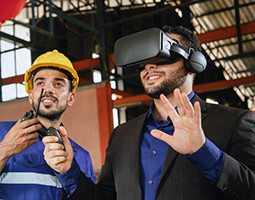April 02, 2025
Scaling AI-enabled digital twins to adapt in manufacturing | Cognizant
Intuitive, real-time visualizations let manufacturing and warehouse managers model changes without downtime.
While battling tariffs, inflation, supply chain snags and economic slowdowns, manufacturers must still keep their production lines running efficiently, and warehouse managers must fill customer orders accurately, quickly and at the lowest cost.
Digital twins—virtual simulations of an object or system—should help them react quickly to unpredictable changes in markets, technology or the flow of raw materials and finished products. Adding generative AI to the digital twin can help by finding patterns and suggesting changes that humans might not see.
But in practice, it’s not that simple. Early adopters of digital twins for manufacturing (as well as other industries) found it took too much time and effort to shut down a facility to test changes suggested by the twin. Adding AI to the twin is often too expensive due to the time and cost of training the large language models (LLMs) at the heart of AI, and of gathering training data from siloed sensing devices and simulation platforms.
But Cognizant believes in the potential of real-time, AI-enabled digital twins to help manufacturing and warehouse managers succeed in an uncertain world. To illustrate, we’ll explore how we are leveraging a real-time, AI-enabled 3D platform to help a major manufacturer scale its deployment of digital twins.
Reduced downtime
The value of a digital twin lies in the fact it is virtual, which should make it easier to simulate outcomes and test changes than in a physical environment filled with expensive material and equipment. However, integrating data from the siloed, disparate systems required to create the digital twin is a major effort.
Change management—training and convincing staff to use the digital twin—is the next hurdle. Finally, the user interface on many digital twins is so complex or unrealistic that managers and planners have had trouble using them to simulate changes and understand their effect. As a result, they were forced to pause operations to reconfigure equipment, physical spaces or processes to test the changes. All this made operations less efficient rather than improving them.
In an ongoing engagement, we’ve helped a global building technology and energy solutions company solve these common problems. In this case, we chose NVIDIA Omniverse as the most comprehensive and easiest-to-use platform for integrating data from the multiple legacy systems our clients use to monitor and control manufacturing and warehouse environments. Its 3D interface is also more detailed and realistic than modeling tools. This made it easier for the manufacturer to model and test changes without interrupting operations.
AI training
One of the steepest obstacles to deploying AI is the cost and effort of gathering the high-quality data required to train an LLM. For manufacturers and warehouse operators, this is even more challenging—the required sensor and modeling data is often stored in multiple formats in various legacy systems.
Ideally, a 3D modeling platform seamlessly reformats data from multiple sensing and Internet of Things systems, as well as legacy CAD/CAM platforms, into the industry standard Universal Scene Description file format. Reusing this data also eliminates the need to rip and replace legacy platforms and lets customers and AI applications learn from earlier reconfigurations.
Such a platform should also generate synthetic data (that is, automatic modifications of actual data) to train an LLM for variations in a physical environment under various scenarios without waiting to gather that data from actual sensors. For our manufacturing client, NVIDIA Omniverse was a good fit because it meets all these needs.
Siloed applications
Building multiple digital twins for multiple uses, such as space planning, safety monitoring and labor utilization adds to cost but provides no benefits. It’s important to find an AI-enabled 3D platform whose data integration capabilities and software development kit allow enterprises to combine multiple modeling and predictive capabilities in one environment informed by common, real-time data.
This makes for better decision making because various functional managers can model and test the effects of proposed changes, using the same data. This common view makes it easier to make tradeoffs between, say, material flow, capacity planning and asset utilization.
Digital twins for manufacturing: infrastructure is key
To cost-effectively scale their use of AI-enabled digital twins for manufacturing, businesses should carefully choose the infrastructure, platforms and partnerships used in architecting the solution. In our work with this manufacturer, Cognizant leveraged Amazon Web Services’ cloud services to run the application, including AWS Bedrock driving the generative AI application development and AWS SiteWise for asset utilization applications.
Business benefits of AI-enabled digital twins
Through our work with this manufacturing client, we are delivering real-time, 3D, AI-enabled platforms to do the following:
- Optimize, in real time, asset performance, plant layout optimizations, digital “gembas” (walkthroughs of virtual environments) and automation planning.
- Allow the use of augmented and virtual reality for remote collaboration, consultations and immersive training.
- Provide real-time monitoring of KPIs such as capital and operational expenses and ROI, allowing for faster and more accurate responses to changing conditions.
- Enhance workflows, improve efficiency and reduce operational costs.
- Simulate the impact of automated guided vehicles, collaborative robots, computer vision and other technologies.
- Identify energy-saving opportunities and track performance to support sustainability goals.
The business benefits of all these capabilities include improved asset performance, dramatic reductions in the time required for factory and line setups, automation planning, simulations and the time required for digital gembas.
Modeling an uncertain world
Scaling and AI-enabling digital twins brings not only higher productivity and better insights through simulation, modeling and operations, but higher throughput and quality in manufacturing lines. For warehouse managers, this means improved order and inventory accuracy, improved space utilization and reduced operating expenses.
With so much change coming at managers so quickly, Cognizant believes digital twins must, and can, be both effective and efficient.
Sharath Prasad is AVP in Cognizant’s IoT & Engineering practice and is the global offering leader for Cognizant’s Intelligent Operations portfolio, which includes smart manufacturing, smart warehouses and smart utilities. He drives strategy, solutions and growth across smart manufacturing solutions and enables clients to integrate IT & OT systems with IoT to derive insights using generative AI.
Latest posts
Related posts
Subscribe for more and stay relevant
The Modern Business newsletter delivers monthly insights to help your business adapt, evolve, and respond—as if on intuition
















